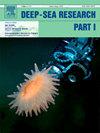Northbound movement of northern fur seal (Callorhinus ursinus) and their response to the oceanographic features
IF 2.1
3区 地球科学
Q2 OCEANOGRAPHY
Deep-Sea Research Part I-Oceanographic Research Papers
Pub Date : 2025-07-18
DOI:10.1016/j.dsr.2025.104558
引用次数: 0
Abstract
Northern fur seals (NFS; Callorhinus ursinus) are a highly migratory otariid species that leave breeding grounds in autumn (October–November), travel south to winter foraging grounds, and return to breeding colonies in early spring (March–April). NFS migrate south to regions with sufficient food, and their movement is hypothesized to be correlated with several oceanographic features. Although southward migration patterns are well-documented, fine-scale information on northbound migration remains limited owing to extended pelagic wintering periods and associated tracking challenges. Using satellite tags, we tracked five juvenile and subadult male NFS from a primary wintering ground in the Sea of Japan to examine their movement patterns, migration pathways, and behavioral responses to oceanographic features. Migration was divided into stay and northbound transit phases based on movement patterns. Slower movements with frequent course changes dominated the stay phase, whereas faster and more directed movements characterized the northbound transit phase. Foraging behavior was concentrated in continental shelf-break regions, where bathymetric features enhance prey availability. Foraging was most frequent within water temperature ranges of 8 °C–13 °C, corresponding to the highly productive Kuroshio-Oyashio Transition Zone. In contrast, transit behavior predominated at water temperatures below 2 °C and above 13 °C, likely reflecting physiological constraints. NFS also exhibited transit behavior near anticyclonic eddy edges, suggesting they use high-velocity regions to reduce travel costs. This study provides valuable insights into the northbound migration strategies of NFS overwintering in the Sea of Japan, demonstrating how they use specific oceanographic features for efficient foraging and movement during migration.
北方海狗的北迁及其对海洋特征的响应
北方海豹(NFS;熊耳花椒(calorhinus ursinus)是一种高度迁徙性的耳科动物,它们在秋季(10 - 11月)离开繁殖地,向南旅行到冬季觅食地,并在早春(3 - 4月)返回繁殖地。NFS向南迁移到食物充足的地区,它们的迁移被认为与几个海洋学特征有关。虽然向南迁移的模式有充分的记录,但由于远洋越冬期延长和相关的跟踪挑战,向北迁移的精细信息仍然有限。利用卫星标签,我们从日本海的一个主要越冬地追踪了5只幼年和亚成年雄性NFS,研究了它们的运动模式、迁徙路径和对海洋特征的行为反应。根据迁移模式,迁移分为停留阶段和向北迁移阶段。较慢的运动和频繁的路线变化主导了停留阶段,而更快和更有针对性的运动是北行过境阶段的特征。觅食行为集中在大陆架断裂区域,那里的水深特征增加了猎物的可用性。8°C - 13°C的水温范围内,与黑潮-沽潮过渡区相对应,觅食活动最为频繁。相比之下,在水温低于2°C和高于13°C时,转运行为占主导地位,可能反映了生理限制。NFS在反气旋涡旋边缘附近也表现出了过境行为,这表明它们使用高速区域来降低旅行成本。这项研究为在日本海越冬的NFS向北迁移策略提供了有价值的见解,展示了它们如何利用特定的海洋特征在迁移过程中有效地觅食和移动。
本文章由计算机程序翻译,如有差异,请以英文原文为准。
求助全文
约1分钟内获得全文
求助全文
来源期刊
CiteScore
4.60
自引率
4.20%
发文量
144
审稿时长
18.3 weeks
期刊介绍:
Deep-Sea Research Part I: Oceanographic Research Papers is devoted to the publication of the results of original scientific research, including theoretical work of evident oceanographic applicability; and the solution of instrumental or methodological problems with evidence of successful use. The journal is distinguished by its interdisciplinary nature and its breadth, covering the geological, physical, chemical and biological aspects of the ocean and its boundaries with the sea floor and the atmosphere. In addition to regular "Research Papers" and "Instruments and Methods" papers, briefer communications may be published as "Notes". Supplemental matter, such as extensive data tables or graphs and multimedia content, may be published as electronic appendices.

 求助内容:
求助内容: 应助结果提醒方式:
应助结果提醒方式:


